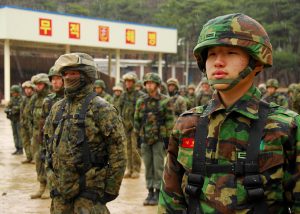The United States and the Republic of Korea (ROK) have concluded their annual command and control exercise called Key Resolve on March 23, U.S. Pacific Command notes in a press statement. Key Resolve was held across the Korean Peninsula from March 8 to March 23.
Key Resolve is a computer-simulated command post exercise. This year’s drill involved approximately 12,800 U.S. Forces along with 10,000 ROK military as well as representatives from the United Nations Command.
“Our mission is first and foremost to deter any aggression from North Korea,” the commander of the Seventh U.S. Air Force, Lieutenant General Thomas Bergeson, said, according to the press statement. “If that deterrence fails then we are in a position to defend the Republic of Korea. And if we defend, we are going to defeat the enemy and win.”
The ROK-United States Combined Forces Command are also simultaneously holding the eight week-long Foal Eagle exercise, which began on March 1 and will run through April. Foal Eagle involves a series of several joint and combined field training operations conducted by U.S. and ROK air, ground, naval and special operations forces.
This year’s iteration is slated to be one of the largest joint U.S.-ROK military drills to date, although amphibious assault and landing operations on a large scale have usually only occurred in even years. Foal Eagle will also include a THAAD anti-missile battery drill. Last year’s Key Resolve and Foal Eagle military exercises involved around 17,000 U.S. troops and more than 300,000 ROK military personnel.
The principal objective of the bilateral military exercises is to test the so-called Korea Massive Punishment & Retaliation (KMPR) battle plan to be executed in the event of military conflict with North Korea. KMPR is a key element of South Korea’s deterrence strategy vis-à-vis the North and complements existing ROK preemptive and defensive strategies. I explained the fundamentals of KMPR elsewhere:
In the event of a North Korean nuclear attack (or even signs of preparations for one), KMPR specifically calls for surgical strikes against key leadership figures of the communist regime and military infrastructure with the missiles part of a so-called kill chain consisting of integrated information, surveillance, and strike systems, as well as the Korea Air and Missile Defense (KAMD) system.
During last year’s military drills, the United States and South Korea practiced the execution of the so-called OPLAN 5015, a classified war plan that mandates precision strikes against North Korea’s nuclear, missile, and command and control facilities. OPLAN 5015 is reportedly part of KMPR. Both Key Resolve and Foal Eagle are conducted in accordance with the ROK-U.S. Mutual Defense Treaty, signed in October 1953.

































